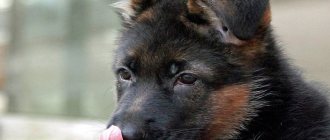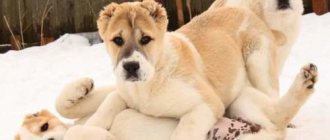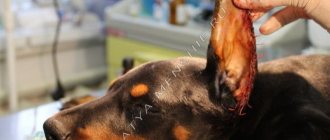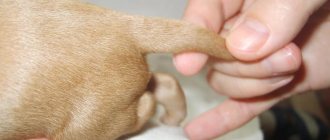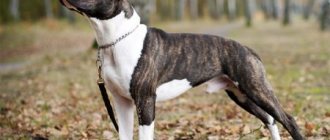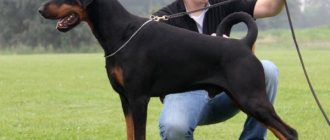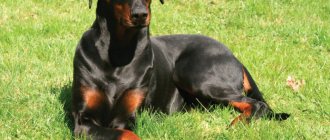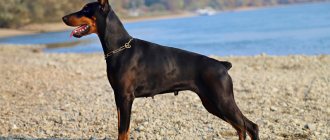Cropping a shepherd's ears is a procedure established by certain standards, which for certain species has a historical justification. Long drooping ears made the dogs vulnerable during fights with wild predators. The operation to shorten the ear is not performed on all shepherd breeds.
For dogs that do not herd herds or encounter predators in nature, this operation is optional and is purely cosmetic. Some species, such as the German Shepherd, for example, simply need to position their ears correctly so that they do not droop.
What dog breeds have their ears cropped?
Currently, the following dog breeds most often have their ears cropped:
- Doberman;
- pit bull terrier;
- Cane Corso;
- miniature pinscher;
- boxer;
- Great Dane;
- schnauzer;
- Staffordshire Terrier;
- Central asian shepherd dog;
- Caucasian Shepherd Dog.
Important: each breed has its own ear cut according to its own pattern. The final shape of the ears should correspond to the appearance of the dog.
How to clean a puppy's ears
In addition to bathing the puppy, feeding, playing and walking, you need to take care of his ears. How to clean the ears of a German Shepherd puppy? Everything is quite simple. This needs to be done regularly.
Cleaning of the auditory organ is done using gauze swabs soaked in a solution of chlorhexidine, or special oil- or water-based solutions sold in pet stores. They carefully remove dirt and sulfur. Only this is done very carefully and safely, so as not to accidentally touch the ear canal. It is better to choose a time when the dog is not in an excited state.
In the end, we will add that in order to prevent improper development of cartilage tissue in a German Shepherd, it is very important to know its pedigree and promptly add biological supplements of calcium and phosphorus if there were dogs with creases among the parents. It is important to start treatment as quickly as possible, otherwise the cartilage will completely lose its elasticity and the ears will always hang.
Shepherd dog ear cropping – reasons and indications
Ear cropping of a shepherd dog is performed for several reasons. Some of them are due to necessity or medical indications, others are a tribute to fashion, following canine standards.
Medical indications:
- Injuries to the ear.
- Tumors.
- Ulcerative lesions.
- Necrosis of ear tissue due to frostbite.
- Burns.
- Prevention of otitis.
- Reducing the likelihood of developing auricular lymphatic extravasation.
Aesthetic reasons:
- Giving a scary look.
- Following the accepted breed standard.
- In the distant past, the ears of dogs that attacked humans were cropped. Thus, a kind of mark was placed on the animal.
Functional reasons:
- Protect your ears from predators. Painful lacerations on the ears disoriented the animal and caused blood loss, infection, and infection.
- Possibility of ear injuries during teenage games of puppies, attempts to divide the territory in adolescence.
- Protection against ear injuries for dogs who have taken part in dog fighting, hunting big game and predators.
- Protection against parasite bites: ticks, mosquitoes.
- Makes it easier to care for the Caucasian Shepherd's ears.
Important: in most European countries today cupping is prohibited unless it is a necessary part of treatment. The exception is dogs in service. In Russia, such a law has not been adopted.
Central Asian Shepherd (Alabai)
Prevention of abnormal development
Knowing at what months a German Shepherd's ears stand up, you can begin to prevent improper development of the auditory organs in advance. It is important to follow some tips for this:
- You should not pet small puppies on the head in the ear canal area, as this can cause creases.
- It is necessary to give your pet a preventive massage of cartilage tissue.
- It is worth caring for your dog with special care, communicating with it and periodically taking it for walks.
- Give the shepherd gelatin diluted in water before each feeding.
- Improve the dog’s nutrition and balance it as much as possible.
- It is important to let your puppy chew on cartilage and bones, as well as special toys.
- When your shepherd is sleeping, you need to make sure that it does not press its head against the wall.
- It is necessary to clean your dog's ears every 2 days.
By following these simple care tips, your pet's hearing organ will develop correctly and rise on time.
Contraindications to ear trimming
Like any surgical procedure, ear cropping surgery has a number of medical contraindications.
So, they don’t do ear amputation:
- sick dogs;
- weakened pets;
- animals of inappropriate age;
- dogs in the recovery period after surgery and severe long-term illnesses;
- puppies with developmental disabilities.
The likelihood of developing complications after surgery depends on the professionalism of the doctor and the reputation of the clinic where the amputation was performed. This operation is expensive, it is not worth saving on it.
Possible complications
Complications are rare, but you need to be aware of them. If cupping was performed in adulthood, bleeding is possible. Sometimes scars and thickening appear. To avoid this, you need to constantly examine the animal and remove the stitches in time.
There is a possibility of inflammation, especially if the operation was performed in unsanitary conditions. It all depends on the owner. Don't rush into cheap and dubious offers. It is better to find a good clinic with specialists who you can trust with the life and health of the animal.
Types of cupping
Depending on the breed, ear trimming is performed in different ways.
- Complete trimming (removal) of the ear - Central Asian and Caucasian Shepherd Dogs.
- Trimming the ear by two thirds - Canary Dogs, Staffordshire Terriers, Cane Corsos.
- Removal of the third part of the ear – miniature pinschers, Dobermans.
- Removal along the entire length - mastiffs.
Important: For shepherd breeds, the ear is completely cut off during docking.
Caring for Cropped Ears
Despite the good outcome of the operation, the dog requires some care after docking. Otherwise, the seams may come apart, inflammation, scars, and deformation of the shape of the ears will appear:
- The pet needs to wear a special collar for a certain time so that it does not harm itself by scratching the stitches with its paws.
- The dog needs to be fed and walked according to its usual schedule.
- The general condition of the ears and sutures should be monitored after surgery. Treat the seam with hydrogen peroxide, streptocide or brilliant green.
- Watch for crust formation. If they appear, treat the ear with a special ointment (for example, Levosin).
- Do not allow dirt to get into the seam.
- The seams will disintegrate within 2 weeks. After this you need to remove the threads. After a few days, you can begin to carry out a special therapeutic ear massage.
- After cropping, the ears must be placed using special frames (for certain breeds).
Ear cropping is sometimes a necessary procedure, and sometimes it is carried out as a tribute to tradition. Consultation with a veterinarian before surgery is required. Not every breed needs docking, most often hunting and fighting breeds. At the moment, truncation of the auricle is prohibited in some European countries. But this ban does not apply to Russia. Moreover, a dog with full ears may not be allowed to participate in the exhibition if its breed requires truncation.
All about ear cropping for Caucasian Shepherd dogs
Let's consider the main features of ear cropping (trimming) of a Caucasian Shepherd dog: indications for cropping, age of the operation, features of the procedure.
At what age is ear cropping performed?
Newborn Caucasian Shepherd puppies undergo complete ear amputation in the first week of life. The optimal age is 1.5 - 3 days. Upon reaching three days of age, the ears of a little Caucasian begin to actively grow and quickly thicken. In exceptional cases, cupping of the concha without anesthesia and sutures is allowed up to seven days of age. If you miss this period, the relief will be more painful, with severe blood loss, and serious postoperative complications may develop.
A Caucasian Shepherd with undocked ears can be operated on by a new owner upon reaching 6-7 months of age. But in this case, you will have to do the procedure under general anesthesia in a veterinary clinic. Late cupping is dangerous due to a long recovery period, severe stress for the pet, large blood loss, and a high level of injury. It is best not to delay this process and cut off the ears in infancy.
How to crop the ears of Caucasian Shepherds
Representatives of this breed undergo a complete trimming of the upper part of the ear. If docking is carried out within the recommended time frame (1.5-3 days), then you can do without visiting a veterinary clinic and do the trimming at home. For Caucasians, there are no uniform patterns for trimming; the breeder or veterinarian conducting the procedure is guided by the length and thickness of the puppy’s ears.
When performing the operation at a later date (6-7 months), you will have to prepare your pet for this serious painful manipulation. The day before the scheduled operation, the dog is not fed and is kept on a starvation diet. The operation is performed under local anesthesia and general anesthesia, so you will have to take the animal to the clinic.
Before the procedure, the ears are shaved to remove hair. Patterns are placed on the ears. The surgical area is carefully treated with antiseptics, after which an incision is made into the cartilage of the auricle from the edge to the central part. After the shepherd dogs' ears are cropped, the incision is processed and stitches are applied. After the wounds have completely healed, they are removed, usually within 8-12 days.
Caucasian Shepherd Dog
What is postoperative care?
A successful operation is only half the battle. Further healing of the injured area will depend on proper post-operative care. Responsibility for this falls on the dog's owner, without whose help the pet cannot cope.
What to do after surgery:
- Put a plastic “Elizabethan collar” on the animal so that the dog does not have the opportunity to scratch the wound.
- Give your dog pain medications as prescribed by your veterinarian to reduce and relieve pain.
- On the first day after the operation, which was performed under general anesthesia, reduce food portions and give food little by little. This will help cope with a possible gag reflex.
- Treat wounds and stitches daily with hydrogen peroxide, brilliant green, calendula tincture or streptocide in powder form. The optimal treatment must be prescribed by a veterinarian. This should be done carefully with cotton pads or cotton swabs.
Important: the owner must carefully monitor the dog’s condition in the postoperative period in order to notice possible deterioration in time and contact a veterinarian.
Possible complications after surgery
When the procedure is performed correctly, complications rarely occur. But, if the operation was carried out by non-professionals, in insufficiently sterile conditions, or the owner did not follow all the recommendations of specialists when caring for the pet after the manipulation, complications may develop.
- Severe bleeding after amputation in adulthood.
- Thickenings and scars form at the site of removal.
- An inflammatory process develops in wounds.
You can avoid these troubles by choosing a professional veterinarian or a good clinic. After the operation, it is necessary to constantly examine the dog and remove the stitches in a timely manner.
Further care
A successful operation is only half the battle. The animal requires special care, on which successful wound healing will depend. Contrary to the common phrase “heals like a dog,” the operated pet will not cope without the help of the owner. To prevent your four-legged friend from scratching his wounds, you need to put a special collar on his neck. The shepherd must take medications for some time. Postoperative sutures also require treatment. When the wounds have healed, the ears will need to be replaced - to do this, they are covered with horns made of adhesive tape and cotton wool.
Ear cropping for Central Asian Shepherd
The procedure for trimming the ears of Alabays (Central Asian Shepherd Dogs) is traditionally carried out in the country of origin of the breed (Russia and CIS countries) and in those countries where this manipulation is not prohibited by law. International breed standards describe undocked dogs. The Russian version allows both types of ears. The decision to carry out the operation is made by the breeder or owner of the Alabai. Let's look at the main arguments for and against the operation.
Arguments of those who advocate docking of Central Asian Shepherds:
- the operation emphasizes the breed, dogs with floppy ears look like mestizos;
- This surgical procedure protects service dogs from certain injuries.
Arguments of opponents of docking:
- surgery is a risk to the dog’s health;
- cupping is purely aesthetic and has no practical benefit;
- This is a painful and uncomfortable procedure for the pet;
- Alabai with cropped ears are more aggressive.
What to do if your ear stands up and then falls again
There are cases when the ear stands up at 3 months, and at 4-5 months one or two ears suddenly fall off. This is a natural phenomenon. It occurs as a result of a puppy's teeth changing. The body, as it were, takes calcium and phosphorus to build a new dental system, depriving cartilage tissue. What to do if your German Shepherd puppy's ears fall off?
You don't need to do anything. The final change of teeth ends at the age of 6-7 months. At this time, the last fangs are erupting. Then the fallen ears should stand up.
But if all 42 teeth have erupted to the end, and the ears still do not rise, you need to immediately consult a dog doctor. After all, the sooner treatment begins, the greater the chance of putting the ears back in place. After a year of a dog’s life, this is almost impossible to do.
Should a German Shepherd's ears be cropped?
Now that we know everything about ear cropping for Caucasians and Alabai, let's talk about the most common breed - the German Shepherd. Representatives of this breed have beautiful erect ears - this is an indicator of compliance with standards and good health of the animal. To achieve this result, you do not need to crop your German Shepherd's ears.
A healthy, well-developing puppy's ears become erect when they reach the age of 2-6 months. Droopy ears in dogs older than six months indicate either a lack of certain minerals in the dog’s diet, or indicate certain genetic pathologies. To set up the ears of a German Shepherd, cropping is not necessary; they are glued in a special way.
Time and age for surgery
Since the procedure is quite painful and can cause blood loss, it is recommended to crop the ears before one week of age. After giving birth, you need to give the baby a few days to get stronger and adapt to the environment. If the puppy feels well, then on the third day the operation can be performed. At this age, anesthesia and stitches are not required. After only a week of age, cartilage tissue thickens and grows, so the procedure will become more painful and traumatic.
Cupping can be complicated by bleeding and stress of the animal. And the healing process will take longer. If you didn’t make it by the week’s deadline, the procedure will have to be postponed for up to six months. After 6 months, the operation is performed under general anesthesia and stitches are applied.
Reasons for deviation, prevention
The causes of deviations from the norm may be hereditary. These include:
- The puppy is not purebred.
- The presence of the same problems in the past in his parents or other relatives.
- Excessively heavy frame.
- Looseness of physique.
- It happens that puppies' ears do not stand up because their mother was poorly fed during pregnancy or she suffered from some rather serious illness.
Important! Most often, how quickly and how reliably a puppy’s ears rise depends primarily on the conditions of his keeping and feeding. Also, the reason for their sagging or collapse can be health problems. Ear drops in adult dogs most often occur due to stress or injury.
Preventive measures that should be taken to prevent problems with ear placement:
- From the first days of arrival in the house, it is necessary to provide your pet with complete and high-quality nutrition. It is especially important to ensure that he receives enough calcium and other essential minerals with food, which is why experienced breeders recommend giving the young shepherd dog as much fermented milk products as possible (with the exception of full-fat sour cream, sweet cheese spreads and yoghurts with sweeteners) and fish. When feeding natural food, it is also recommended to add vitamin and mineral supplements to the food, but if the dog eats ready-made food, this is not necessary.
- The owner must monitor the puppy’s health: conduct preventive examinations, get vaccinations on time, and also promptly rid the pet of external and internal parasites. If the puppy is sick, then it is necessary to begin treatment as quickly as possible.
- In order to develop successfully, the little “German” must move a lot, walk and play. This promotes the overall development of the body and, in particular, improves the growth of cartilage tissue.
- During the cold season, a growing shepherd dog should live in a house or in an insulated enclosure. If you keep it in the cold, the growth of cartilage tissue will be greatly slowed down.
- You need to keep your pet's ears clean: if wax and dirt accumulate in them, this can lead to inflammation, as a result of which the ears will not be able to rise for a long time.
- Small children should not be allowed to pull his ears when playing with a puppy, and in the same way, other dogs should not be allowed to do this when they are playing with a small shepherd.
- Well-developed jaw muscles contribute to the correct positioning of the ear, so it is the owner's responsibility to ensure that his pet has plenty of chewing toys.
Important! In order for the ears to quickly take the correct shape, experts recommend massaging them from time to time, starting from the base to the tips.
Return to content
What to do?
If your dog is more than six months old and his ears are still drooping, then they will have to be rewound. Before the procedure, be sure to consult a specialist.
It is important not to tape your dog's ears until he is six months old. Too early a procedure can cause damage to the ear.
Rewind
First you need to purchase materials. What you need for rewinding:
- large foam rollers;
- white surgical plaster in a spool;
- medical glue (preferably special dog glue, sold in veterinary pharmacies);
- wooden stick for fixing ears.
When everything you need has already been purchased, proceed to the procedure. Make sure everything is sterile and wash your hands thoroughly. The dog must be calm. The procedure is as follows:
- Wipe your puppy's ears with an antiseptic.
- Take curlers. Take the center out of them, leaving only the foam base. Take a pencil and insert it into the hole with the eraser first, but not all the way. The pencil is needed for stabilization; it will then need to be removed.
- Apply medical glue to the outside of the curler. Make sure there is not too much glue so that it does not get into the ear canal.
- Place your ear in a vertical position and attach curlers to the hanging part. Leave some distance between the edge of the curler and the dog's head so as not to close the ear canal. Apply a little pressure to your ear so that the curler can secure itself.
- While holding the pencil, wrap a bandage around your puppy's ear. Do not attach the patch too tightly so as not to cause discomfort to your pet. When it's all over, put the pencil away.
- Attach a wooden stick to the back of the ear. This will secure the ears in a standing position.
- After all the steps, it will take about 5-7 minutes for the patch to attach. Distract your puppy during this time: feed him a treat or play.
The patch is worn for 10-14 days.
Alternative way
Alternative ear fixation:
- Gently feel your dog's ears for weak cartilage. When you find one, the ears will immediately straighten.
- Cut a piece of cardboard slightly larger than the problematic cartilage.
- Disinfect your puppy's ears. Take an adhesive plaster and stick it on the weak cartilage. Lubricate a piece of cardboard with medical glue. Stick it on the plaster, then secure it with the 2nd layer of plaster.
Breeders and veterinarians prefer the first method. But if you don’t like it, the right to choose remains yours.
Basic moments
- Caucasian Shepherd Dogs are only friendly towards members of the family in which they live. All unfamiliar people and animals are viewed through the prism of mistrust.
- Dogs have lightning-fast reactions. Always ready to defend the owner and his property.
- Caucasian wolfhounds are not bloodthirsty, but they are quite aggressive, so they need a firm hand. People who do not have the skills to raise and train guard dogs should think more than once before acquiring a “Caucasian”.
- Shepherds are phenomenally sensitive. A sleeping pet is able to detect the slightest rustles and noises.
- Dogs can tolerate cold relatively easily, so they feel great in an enclosure and kennel.
- Caucasian Shepherds calmly tolerate their owner's absences and do not require special attention. They can sit for hours, taking a wait-and-see attitude and looking out for potential trespassers.
- Representatives of the breed grow slowly, reaching full physical and mental maturity only by 2 years.
- The dogs are smart and trainable, although they are inferior to German shepherds in the speed of mastering basic commands.
- Caucasian Shepherds are easily wound up and uncontrollable in anger. A raging “Caucasian” is capable of fairly fraying the skin and nerves of even the most eminent representative of the fighting breed.
- Animals have good intuition and easily determine “by eye” the degree of possible danger.
Is it necessary to dock the tail?
Based on aesthetic considerations, then more likely yes than no, especially when plans include ear cropping. In the early stages, docking the Caucasian Shepherd's tail will be less painful than at an older age. In this case, the animal faces a serious operation using general anesthesia.
You can painlessly and quickly tail dock from the 3rd to the 10th day of a puppy’s life. There are enough ways to do this, but any of them must be applied by a specialist.
The following video is not recommended for viewing by children and people with weak mental health.
Advantages and disadvantages
The advantages include a well-groomed appearance and a familiar appearance.
There are significantly more downsides to it. These dogs are among the breeds that may experience behavioral disturbances after experiencing pain. Ears also play an important role in the animal’s communication with both humans and its fellow animals. For example, if a dog raises its ears, it means it senses danger, and if it tightens its ears, it means it obeys. Removal deprives her of the opportunity to express her emotions and fully communicate.
